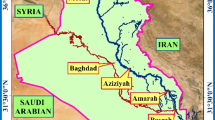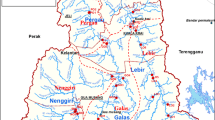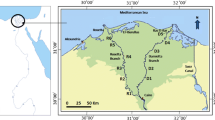Abstract
Cameron Highlands is experiencing rapid development as a popular tourist destination in Malaysia. This causes a rapid boost in construction and other tourism-related activities, such as the growth of vegetables, fruits and flowers. Due to that, the water quality of rivers in the highlands has been adversely affected. In this study, Bertam River, as one of the main streams in Cameron Highlands, was monitored to assess its suitability for recreational activities and conservation. Seven sampling points were selected in the river and tributaries: dissolved oxygen, biochemical and chemical oxygen demands (BOD and COD), total suspended solids (TSS), ammonia nitrate (NH3–N) and pH were measured and the water quality index (WQI) was computed during high and average water flow. In addition, water quality surface data were generated from the sampling points using the interpolation technique of geographic information system to predict values of unknown locations. Results show that TSS, BOD and NH3–N contribute most to the pollution of the waters. This is due to earthworks in the highlands as well as poorly treated sewage discharges from hotels, rest houses and apartments. WQI results indicate that Bertam River and its tributaries are classified as class II, III and IV, which require extensive treatment before utilization in most of the locations. Consequently, to improve the water quality of the rivers, recommendations have been made to ensure that some sampling points with potentials for recreational activities attain class II and subsequently class I in the near future.






Similar content being viewed by others
References
Abed MH, Monavari M, Karbasi A, Farshchi P, Abedi Z (2011) Site selection using Analytical Hierarchy Process by geographical information system for sustainable coastal tourism. Paper presented at the Proceedings International Conference Environmental and Agriculture Engineering, Chengdu, China
APHA (1992) Standard methods for the examination of water and wastewater, 18th edn. American Public Health Association (APHA), Washington, DC
Azpurua M, Ramos K (2010) A comparison of spatial interpolation methods for estimation of average electromagnetic field magnitude. Progress in Electromagnetics Research M 14:135–145
Beedasy J, Whyatt D (1999) Diverting the tourists: a spatial decision-support system for tourism planning on a developing island. ITC J 1(3):3–4
Berry JK (1991) GIS in island resource planning: a case study in map analysis. In: Maguire D et al (eds) Geographical information systems, vol 2. Longman Applications, Harlow
Boers B, Cottrell S (2007) Sustainable tourism infrastructure planning: a GIS-supported approach. Tour Geogr 9(1):1–21
Bunruamkaew K, Murayam Y (2011) Site suitability evaluation for ecotourism using GIS and AHP: a case study of Surat Thani province, Thailand. Proce Soc Behav Sci 21:269–278
Butler RW (1993) Tourism—an evolutionary perspective. In: Nelson JG, Butler RW, Wall G (eds) Tourism and sustainable development monitoring, planning, managing. Department of Geography, University of Waterloo, Waterloo
Chang K (2004) Introduction to geographic information systems. McGraw Hill, New York, p 200
Cornell-University (2013) Household wastewater treatment including septic systems
DID (2004) Drainage master plan study and flood mitigation project for Cameron Highlands. Department of Irrigation and Drainage Pahang (DOE) Government of Pahang
DOE (2002) Malaysia environmental quality report. Department of environment (DOE), Ministry of Science, Technology and Environment, Malaysia
Dye AS, Shaw S (2005) A GIS-based spatial decision support system for tourists of Great Smoky Mountains National Park. J Retail Consum Serv 14(2007):269–278
Eisakhani M, Malakahmad A (2009) Water quality assessment of Bertam River and its tributaries in Cameron Highlands, Malaysia. World Appl Sci J 7(6):769–776
Eisakhani M, Pauzi A, Karim O, Malakahmad A (2011) Investigation and management of water pollution sources in Cameron highlands, Malaysia. WIT Trans Ecol Environ 148:231–241
Eisakhani M, Pauzi A, Karim O, Malakahmad A (2012a) Conceptual approaches to improving water quality of rivers in Cameron highlands, Malaysia. J Sustain Sci Manag 7(2):213–219
Eisakhani M, Abdullah MP, Karim OA, Malakahmad A (2012b) Validation of MIKE 11 model simulated data for biochemical and chemical oxygen demands transport. Am J Appl Sci 9(3):382–387
EPA (2002) “Onsite Wastewater Treatment Systems Manual,” Office of Water, Office of Research and Development, U.S. Environmental Protection Agency, Washington, DC, EPA/625/R-00/008
EPA (2005) Protecting water quality from agricultural runoff. Non-point source control branch. U.S. Environmental Protection Agency, Washington, DC,EPA 841-F-05-001
EPA (2013) Urban Nonpoint Source Fact Sheet; Office of Water. U.S. Environmental Protection Agency, Washington, DC, EPA 841-F-03-003
ESRI (2007) ArcGIS 9.2 Desktop Help. How Inverse Distance Weighted (IDW) interpolation works. Environmental Systems Research Institute
Freeman D (1999) Hill station or horticulture? Conflicting imperial visions of the Cameron Highlands, Malaysia. J Historic Geogr 25(1):17–35
Ginting D, Mamo M (2006) Measuring runoff-suspended solids using an improved turbidometer method. J Environ Qual 35:815–823
Gössling S (2006) Tourism and water. In: Gössling S, Hall CM (eds) Tourism and Global environmental change: Ecological, social, economic and political interrelationships. Routledge, Abingdon, pp 180–194
Gray NF (ed) (2005) Water basin management, 2nd edn. Water Technology, UK, pp 115–152
Hall CM, Härkönen T (eds) (2006) Lake tourism: an integrated approach to lacustrine tourism systems. Channel View Publications, Clevedon
Hoover AM (1997) Analysis of water quality in Lake Erie using GIS methods. Master Thesis
Ismail BS, Sujaul IM, Muhammad BG, Sahibin AR, Mohd ET (2012) Hydrological Assessment and Water Quality Characteristics of Chini Lake, Pahang, Malaysia. Am Eur J Agric Environ Sci 12(6):737–749
Kumaran S, Ainuddin AN (2004) Forests. Faculty of Forestry, Universiti Putra Malaysia, Water and Climate of Cameron Highlands
Malakahmad A, Eisakhani M (2008) Kutty SRM (2008) GIS based Point and Non-point Sources of Pollution Identification in Cameron Highlands. International conference on construction and building technology, ICCBT
Malakahmad A, Eisakhani M, Isa MH (2008) Developing MIKE-11 Model for water quality simulation in Bertam River. Cameron Highlands; International conference on construction and building technology, ICCBT
Masters GM (1998) Introduction to environmental engineering and science, 2nd edn. Prentice Hall, Upper Saddle River, NJ
Meyer C (2003) Evaluating water quality using spatial interpolation methods, Pinellas county, Florida. Pinellas County Department of Environmental Management, USA
Minagawa M, Tanaka N (eds) (1998) Application of geographic information systems to tourism development planning: a case study of Lombok, Indonesia. Nagoya: UNCRD Research report Series No. 27
MNS (2000) Cameron Highlands-Worth Saving or Not; Press release. Malaysian Nature Society (MNS), Malaysian
Norhayati MT, Goh SH, Tong SL, Wang CW, Abdul Halim S (1997) Water quality studies for the classification of Sungai Bernam and Sungai Selangor. Ensearch Malaysia 10:27–36
Prideaux B, Cooper M (eds) (2009) River Tourism. CABI, Wallingford
REACH (2009) Development has gone unsustainable. Regional Environmental Awareness Cameron Highlands (REACH). Organization Review Report
Shuhaimi-Othman M, Lim E, Mushrifah I (2007) Water Quality Changes in Chini Lake, Pahang, West Malaysia. J Environ Monitor Assess 131:279–292
Taylor A, Wong T (2002) Non-structural stormwater quality best management practices—an overview of their use, value, cost and evaluation. Cooperative research center for catchment hydrology, technical report 02/11
Tong SL, Goh SH (1997) Water quality criteria and standard development and river classification in Malaysia. Ensearch Malaysia 10:15–26
TSWQS (2012) Recreational Use-Attainability Analyses (RUAAs): Procedures for a Comprehensive RUAA and a Basic RUAA Survey; Texas Surface Water Quality Standards (TSWQS), Feb 2012
UMN (2013) Limiting Impact of Recreation on Water Quality; Fact sheet to assist shore land property owners in protecting and preserving water quality. University of Minnesota (UMN) Extension
UNESCO (2009) Water in a Changing World. United Nations Educational, Scientific and Cultural Organization (UNESCO), United Nations World Water Development Report 3
UNISDR (2009) Terminology on Disaster Risk Reduction. United Nations International Strategy for Disaster Reduction (UNISDR), Geneva
USU (2014) Agriculture and water quality. Utah State University (USU)
Van der Ent A, Termeer C (2005) Study on river water quality of the Upper Bertam catchment. Saxion University, Institute of Spatial Planning and Environmental Science, Deventer
Yogendra K, Puttaiah E (2008) Determination of water quality index and sustainability of an urban water body in Shimoga town, Karnataka. In: Proceedings of Taal 2007: the 12th world lake conference pp 342–346
Zapanta I, Salandanan M, Directo M, Mamadra U, Nicolas J, Cruz A (2008) Water quality report of the seven crater lakes. Environmental Quality and Research Division, Laguna Lake Development Authority, Laguna
Zha L, Wang Y (2010) Research on Regional Tourism Planning Spatial Decision Supporting System: 2010 Sixth International Conference on Natural Computation (ICNC 2010)
Acknowledgments
The authors express their deep appreciation to Malaysia’s Ministry of Education (MoE) through exploratory research grant scheme (ERGS 15-8200-130) for funding this project.
Author information
Authors and Affiliations
Corresponding author
Rights and permissions
About this article
Cite this article
Aminu, M., Matori, AN., Yusof, K.W. et al. A GIS-based water quality model for sustainable tourism planning of Bertam River in Cameron Highlands, Malaysia. Environ Earth Sci 73, 6525–6537 (2015). https://doi.org/10.1007/s12665-014-3873-6
Received:
Accepted:
Published:
Issue Date:
DOI: https://doi.org/10.1007/s12665-014-3873-6




